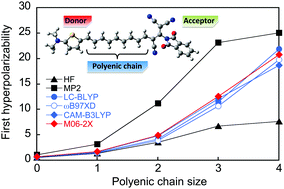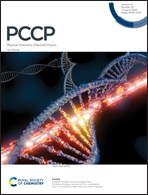Performance of DFT functionals for calculating the second-order nonlinear optical properties of dipolar merocyanines†
Abstract
The second-order nonlinear optical responses of a series of recently designed dipolar merocyanines are investigated using the 2006 Minnesota family of hybrid exchange–correlation functionals (XCFs), as well as the LC-BLYP, ωB97XD and CAM-B3LYP long-range (LR) corrected XCFs. The performance of these different levels of approximation is discussed in regard to reference second-order Møller–Plesset calculations and experimental data obtained from Hyper-Rayleigh Scattering (HRS) measurements. Particular focus is given to the influence of the amount of exact Hartree–Fock exchange included in the XCF on the magnitude of the static HRS responses, as well as to the impact of tuning the range-separation parameter in LR-XCFs, according to a system-specific nonempirical procedure. Frequency dispersion effects are also investigated, as well as their crucial role in the comparison between theoretical and experimental data.

- This article is part of the themed collection: 2020 PCCP HOT Articles


 Please wait while we load your content...
Please wait while we load your content...